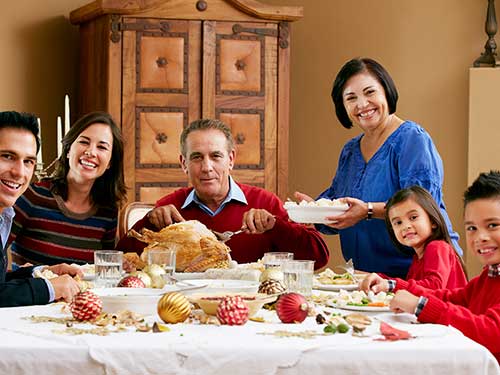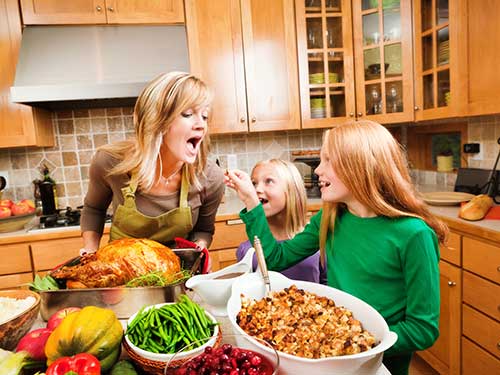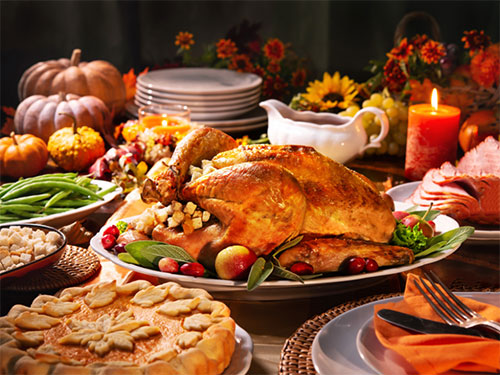
Bulletin E234
How Much Turkey Should I Buy?
Allow for 1 to 1 ½ pounds of uncooked turkey per person. This will yield approximately 10 ounces of cooked turkey meat per person—enough for a filling meal and leftovers.
Should I Buy a Fresh or Frozen Turkey?
USDA's Food Safety and Inspection Service inspects both fresh and frozen poultry. The quality is the same. Whether you select a fresh or frozen bird is simply a matter of personal preference. Fresh turkeys need no thawing and are ready to cook. Frozen turkeys can be purchased months in advance – just remember to plan enough thawing time before roasting!
Prior to 1997, poultry could be sold as "fresh," even if it was frozen. Today, the definitions of "fresh" and "frozen" turkey are intended to meet the expectations of consumers buying poultry:
- Frozen Turkey – Raw turkey held at a temperature of 0°F or below must be labeled "frozen" or "previously frozen."
- Fresh Turkey – Turkey that has never been below 26°F, i.e. not hard-to-the-touch or frozen solid, may be labeled "fresh."
All raw turkey (fresh or frozen) can be kept safe when stored at 40°F or below.
Where Can I Find Fresh Turkey in New Jersey?
Many local farm markets, butchers, and grocery stores sell fresh turkeys at Thanksgiving. Check with them about ordering, purchasing, and availability. Be sure to plan ahead. Most retailers require that you place turkey orders in advance.
Local farms are a wonderful source of fresh meats and produce. "Shopping local" is a great way to promote sustainability in your local community. By purchasing your Thanksgiving turkey and other holiday ingredients from a local farmer, you receive quality products at their peak freshness. You also give back to your local economy by increasing jobs in your area and providing farmers with money that will be reinvested into your community. There are also environmental benefits, such as decreased transportation and fuel usage that go along with buying local. To find a farm in your area that carries fresh turkey and other Thanksgiving necessities, go to jerseyfresh.nj.gov and VisitNJFarms.org.
Can You Explain Some of the Words I'm Reading on the Turkey Label?
As with any food product, poultry manufacturers use the food label to describe the product they're selling. These are some of the more common terms on a turkey's label:
The USDA National Organic Program administers these regulations, with substantial input from its citizen advisory board and the public.
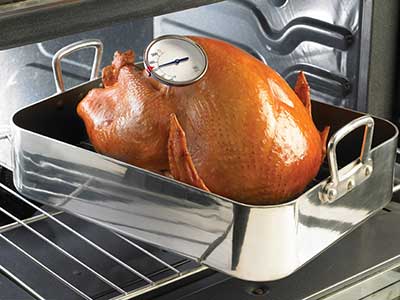
How Should I Handle My Turkey so It's Safe to Eat?
How Should I Defrost (Thaw) My Turkey?
After purchase, frozen turkeys should be placed in a freezer until ready to be thawed. There are three safe ways to thaw a turkey:
- Refrigerator: It is best to plan ahead for slow, safe thawing in the refrigerator. Your turkey will require at least a day (24 hours) for every 5 pounds of turkey weight.
- Cold Water: This method is faster than refrigerator thawing, but requires more attention. The turkey should be in leak-proof packaging or a plastic bag. Submerge the turkey in cold tap water, changing the water every 30 minutes. It will take about 30 minutes per pound. After thawing, refrigerate the turkey and cook it promptly. Turkey thawed by the cold water method should be cooked before refreezing.
- Microwave: All microwaves are different. Check the manufacturer's instructions for the size turkey that will fit into your oven, the minutes per pound, and the power level to use for thawing. After microwave thawing, cook the turkey immediately, because some areas of the turkey may become warm and begin to cook. Holding partially cooked food is never recommended. Any bacteria present will not be destroyed in the microwave, and the turkey may reach temperatures at which bacteria can grow while in the microwave. Foods thawed in the microwave should be cooked before refreezing.
Once thawed in the refrigerator, turkey can remain refrigerated for a day or two before cooking. Turkey thawed in the refrigerator can be safely refrozen without cooking, although there may be some loss of quality.
| Turkey Size | Days to Defrost |
|---|---|
| 8–12 Pounds | 1–2 Days |
| 12–16 Pounds | 2–3 Days |
| 16–20 Pounds | 3–4 Days |
| 20–24 Pounds | 4–5 Days |
| 24–28 Pounds | 5–6 Days |
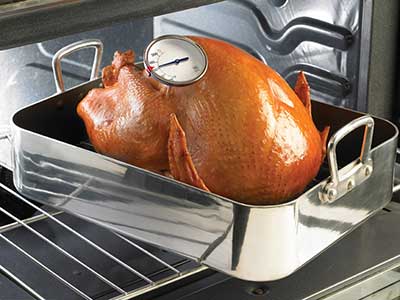
What's the Proper Way to Stuff a Turkey?
As with any preparation involving raw food ingredient, it's important to carefully follow proper food safety and handling procedures to ensure safe turkey and stuffing every time. For consumers who choose to stuff their turkeys, follow these guidelines:
How Should I Roast My Turkey?
Regardless of your recipe or your cooking method, these tips offer superb strategies to assure that your turkey is tasty and safe to eat.
What Is the Right Way to Use a Meat Thermometer?
Using a meat thermometer is the only reliable way to ensure safety and to determine the "doneness" of your turkey and side dishes.
How Can I Tell When the Turkey and Stuffing Are Done?
Turkey and stuffing are done when the meat thermometer reaches 165°F.
| Turkey Weight (lb) | Estimated Time for Unstuffed Turkey | Estimated Time for Stuffed Turkey |
|---|---|---|
| 8–12 | 2 ¾–3 hours | 3–3 ½ hours |
| 12–14 | 3–3 ¾ hours | 3 ½–4 hours |
| 14–18 | 3¾–4 ¼ hours | 4–4 ½ hours |
| 18–20 | 4¼–4 ½ hours | 4 ½–4 ¾ hours |
| 20–24 | 4½–5 hours | 4 ¾–5 ¼ hours |
| 24–28 | 5–5 ¾ hours | 5 ¼–5 ¾ hours |
How Long Can Thanksgiving Dinner Sit out before It Is Unsafe to Eat?
Thoroughly cooking food before you serve it helps kill most harmful bacteria that cause foodborne illness, but cooking's effects won't last forever. Serve food carefully to keep food safe:
How Can I Keep Leftovers Safe?
Having leftover food for a few extra meals (or snacks) can be one of the best things about Thanksgiving. Just remember, food won't keep forever! Store it only for a limited time and store it carefully to keep it fresh and safe.
How Long Will Leftovers Keep?
Use refrigerator leftover turkey and stuffing within 3 to 4 days, gravy within 1 to 2 days, or freeze these foods.
Remember, you can't always smell, taste, or see bacteria. Storage time is your best guide to determine whether a food can be reheated or should be discarded. Don't trust your senses to guide you. Food may look or smell fine, even when it's covered with harmful bacteria.
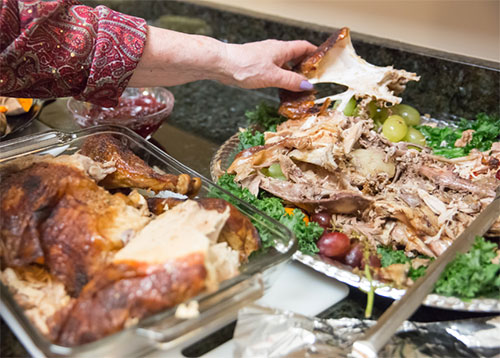
How Should I Reheat Leftovers?
Heat sauces, soups, and gravies to a rolling boil.
Cover and reheat leftovers to 165°F.
Microwave leftovers in microwave-safe containers, using a lid or vented plastic wrap. If the microwave doesn't have a turntable, turn the entire dish several times during cooking time. Always stir soups, stews, stuffing, and gravies several times during cooking. And, always check for doneness with a thermometer.
What's microwave safe? Glass cookware, glass ceramic cookware, and waxed paper are safe for microwave cooking.
Plastic wrap may be used to cover containers, but should not touch the food. Before using other types of containers, wraps, or paper products, check to make sure that they are approved for use in the microwave. Unapproved materials may melt, burn, or contain chemicals that can migrate into food during cooking.
Contact FCHS at your local Rutgers Cooperative Extension office for information on programs and resources available in your county. Need help finding us? Visit njaes.rutgers. edu/county for a statewide directory.
Food Safety Resources for Additional Information:
Rutgers Cooperative Extension
Other Useful Resources
Contact FCHS at your local Rutgers Cooperative Extension office for information on programs and resources available in your county. Need help finding us? Visit njaes.rutgers.edu/county for a statewide directory.
Turkey Anytime: A Recipe for Turning Leftovers into Planned-Overs
Source: Alice Henneman, MS, RD, Extension Educator, University of Nebraska Lincoln
Part of the pleasure of a Thanksgiving or other holiday meal is the aroma of a turkey baking in the oven. Continue that great feeling by planning a variety of pleasing post-holiday meals with leftover turkey. Try these recipes, created by University of Nebraska Extension, or use them as inspiration for your own! Turkey makes a great first meal plus delicious leftovers that are easy to combine into a variety of scrumptious future meals.
Turkey and Cranberry Salad
Serves 4
Ingredients:
- 1 ½ cups turkey, cooked and diced
- ¼ cup vinaigrette dressing
- 1 cup dried cranberries or cherries
- 2 tablespoons sliced almonds
- Lettuce leaves
Directions:
- Toss chicken, cranberries, and almonds with dressing. Serve on a lettuce leaf or mound of chopped lettuce.
White Turkey Chili
Source: Mary Torell, Public Information Officer, Nebraska Dept. of Agriculture, Poultry and Egg Division
Serves 8
Ingredients:
- 1 tablespoon oil
- ¼ cup onion, chopped
- 1 cup celery, chopped
- 4 cups cooked turkey, chopped
- 2 cans (15.5 oz.) Great Northern beans, drained
- 2 cans (11 oz.) corn, undrained
- 1 can (4 oz.) chopped green chilies
- 4 cups turkey or chicken broth
- 1 teaspoon ground cumin
Directions:
- Heat oil in a skillet over medium heat. Add onion and celery, cook and stir 2–3 minutes. Place all ingredients in a large saucepan (at least 4 quarts). Stir well. Cover and cook about 15 minutes over medium heat stirring occasionally until thoroughly heated.
Turkey Stew
Source: Adapted from: Montana Extension Nutrition Education Program Website Recipes
Serves 4
Ingredients:
- 2 teaspoons vegetable-oil
- ½ cup chopped onion
- 1 finely chopped garlic clove or ½ teaspoon garlic powder
- 4 chopped carrots
- 2 chopped celery stalks
- 2 chopped potatoes
- 1 can (15 ounce) tomatoes, diced
- 2 cups water
- 2 cups chopped, cooked turkey
- Italian seasoning or oregano, basil or thyme to taste
- Salt and pepper to taste
Directions:
- Heat oil in medium saucepan. Add onion, garlic, carrots and celery and stir two minutes. Add potatoes, tomatoes, and water to pan. Bring to a boil, then lower heat and simmer 30 minutes or until vegetables are tender. Add turkey and cook another five minutes or until heated. Season to taste before serving.
March 2015
Copyright © 2024 Rutgers, The State University of New Jersey. All rights reserved.
For more information: njaes.rutgers.edu.
Cooperating Agencies: Rutgers, The State University of New Jersey, U.S. Department of Agriculture, and Boards of County Commissioners. Rutgers Cooperative Extension, a unit of the Rutgers New Jersey Agricultural Experiment Station, is an equal opportunity program provider and employer.


